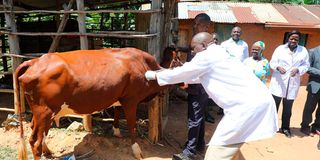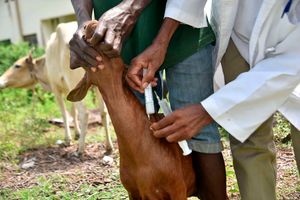500,000 cattle vaccinated against foot-and-mouth since January

Livestock veterinary officer Bernard Odera vaccinates a cow against foot-and-mouth disease on January 15, 2025 at Handidi village in Shinyalu, Kakamega County.
More than 500,000 cattle have been vaccinated against foot-and-mouth disease (FMD) in 36 counties since the start of a national vaccination campaign ordered by the President last month.
The process will cover 22 million cattle and 50 million goats over a two-year period starting in January this year. This is according to the Directorate of Veterinary Services.
The FMD vaccination campaign, part of a wider animal health initiative, is aimed at controlling a disease that has devastated herds and led to quarantines in several counties.
"The government's intention is to implement the vaccination programme in order to protect livestock in accordance with national, regional, and global control and eradication strategies against FMD," said Dr Allan Azegele, the director of Veterinary Services.
Foot-and-mouth disease, which causes painful blisters in animals' mouths and feet leading to significant production losses, has been particularly challenging to control due to its highly contagious nature. The disease is classified as "trade-sensitive" by the World Organization for Animal Health, meaning its presence restricts Kenya's ability to participate in international livestock markets.
Official data shows that Uasin Gishu County leads the FMD vaccination effort with 69,360 cattle vaccinated, followed by Nakuru (52,320), Trans Nzoia (46,240) and Turkana (42,000). Other counties with substantial FMD vaccination numbers include Kakamega (30,000), Taita Taveta (27,280) and Meru (26,960).
"These diseases cause significant loss in production and productivity of our livestock, threatening food security, food safety, economic losses due to closure of markets, treatment costs, and losses through high mortality of animals," Dr Azegele explained.
The FMD vaccination campaign became particularly urgent following outbreaks that led to quarantines in four counties -- West Pokot, Nandi, Trans Nzoia and Kakamega. Government data shows that vaccination efforts have already reached these affected areas, with West Pokot receiving over 9,120 FMD vaccine doses. However, Nandi is yet to start the vaccinations as it is not listed among the counties that have received the doses in the DVS data.
While the DVS report does not provide FMD-specific immunity rates, pre- and post-vaccination surveys in Embu, Tharaka Nithi and Kitui counties show improvements in herd immunity levels for the targeted diseases.
"In monitored counties, immunity rates jumped from single-digit or low double-digit percentages to over 80 percent after vaccination. The World Organization for Animal Health recommends vaccination coverage of at least 80 percent to effectively control these diseases—a threshold these counties have now surpassed. The results indicate herd immunity in line with World Organization of Animal Health standards," Dr Azegele said in the report.
Before the mass vaccination began, there was a lot of opposition from a section of politicians and the Kenya Veterinary Association, accusing the government of harbouring a sinister motive. The KVA also expressed concern that the Kenya Veterinary Vaccine Production Institute (KEVEVAPI) did not have the capacity to produce the doses needed to run a successful campaign.
But Dr Azegele said, "KEVEVAPI has sufficient capacity to supply vaccines as and when required for the programme."
Contrary to reports of farmer resistance to the vaccination drive, the Directorate claims there is "high demand for the vaccines" across the country, even though not all counties have been reached yet.
While FMD vaccination is a primary focus, the campaign simultaneously targets other critical livestock diseases.
Since 2024, the initiative has administered more than 4.2 million doses of Peste des Petits Ruminants (PPR) vaccine, primarily in counties with large populations of sheep and goats.
Counties with nomadic pastoralist communities have seen some of the highest PPR vaccination rates. Wajir leads with 930,000 PPR vaccinations, followed by Turkana with 590,000, and Isiolo with 518,851.
The programme has also addressed other priority diseases, including Contagious Caprine Pleuropneumonia (CCPP) with 892,657 doses, Rift Valley Fever (RVF) with 1,110,000 doses, Blue Tongue with 450,000 doses, and Contagious Bovine Pleuropneumonia (CBPP) with 226,941 doses.
In total, the campaign has vaccinated more than 7.5 million animals against various diseases since its inception, making it one of the most ambitious animal health initiatives in the region. The campaign was officially launched on January 30, 2025 in Sergera ward, Kisargei village, Laikipia North sub-county.
While the Directorate of Veterinary Services says the FMD vaccination campaign has made significant progress, data shows that coverage remains uneven across the counties. Some regions have reported relatively low vaccination rates, suggesting that the campaign still has some way to go to achieve full national coverage. In addition, the data provided only cover 36 counties, with data from 11 counties missing but no explanation given.
"Vaccinations have been going on in accordance with the strategies in place," said Dr Azegele.
"Despite challenges and criticisms, the national programme will continue as planned, building on the substantial progress already achieved."
***
Understanding Foot and Mouth Disease
What is foot-and-mouth disease?
Foot-and-mouth disease (FMD) is a highly contagious viral infection that affects cloven-hoofed animals, including cattle, sheep, goats, pigs and wildlife such as buffalo. It's caused by an aphthovirus of the Picornaviridae family. The disease is characterised by high fever followed by blisters (vesicles) in the mouth and on the feet, especially around the hooves.
Is it harmful to humans?
FMD is not considered a significant threat to human health and should not be confused with hand, foot and mouth disease, which affects humans. However, people can carry the virus on their clothes, shoes or bodies and spread it to animals.
How does FMD spread?
The virus spreads rapidly by:
- direct contact between infected and susceptible animals
- airborne transmission through respiratory droplets
- contaminated feed, equipment, vehicles or clothing
- movement of infected animals or animal products
The virus can spread up to 60 kilometres by air in favourable weather conditions, making containment particularly challenging.
Why is FMD so feared in the livestock industry?
FMD rarely kills adult animals, but causes extreme suffering and devastating production losses:
- Drastic reduction in milk production (up to 80 percent reduction)
- Severe weight loss as animals struggle to eat due to mouth sores
- Lameness due to foot lesions
- Abortion in pregnant animals
- High mortality of young calves
- Long-term productivity problems even after recovery
Economic impact:
A single FMD outbreak can cripple the livestock industry:
- Immediate loss of international export markets, which may take years to recover
- Costs of quarantine and movement restrictions
- Cost of vaccination or culling programmes
- Reduced market value of recovered animals
- Loss of genetic stock for breeding programmes
Why vaccinate rather than cull?
In countries where FMD is endemic, such as Kenya, vaccination is preferred to culling for a number of reasons:
- Culling would cause catastrophic losses in a country where livestock is a major source of wealth and food security.
- Regular vaccination is more sustainable in the long term.
- Vaccination allows continued production while building herd immunity
- It aligns with global strategies for eventual disease eradication.
The challenges of vaccination:
FMD vaccination is particularly complex because
- There are multiple strains (serotypes) and vaccines are strain specific
- Vaccines provide relatively short-term immunity (6-12 months)
- Cold chain requirements make distribution in remote areas challenging
- Regular boosters are needed to maintain protection
- Coverage must reach at least 80 percent of susceptible animals to be effective
Global context:
FMD is a notifiable disease to the World Organisation for Animal Health (WOAH). Many developed countries have eradicated FMD through strict border controls and rigorous surveillance. However, it remains endemic in parts of Africa, Asia and the Middle East, requiring continuous vaccination programmes.
Source: Department of Veterinary Services


